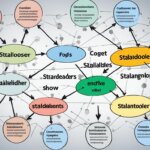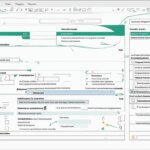Table of Contents
Behavior-Driven Development (BDD) is an extension of Test-Driven Development (TDD) that focuses on writing tests first and then adding application code. The BDD framework emphasizes collaboration, user-focused tests, and the benefits it brings to software development.
With BDD, the tests are written in plain descriptive English grammar, describing the behavior of the application. This approach aims to create a common language that can be easily understood by business stakeholders, analysts, QA teams, and developers.
The BDD framework, such as Cucumber or JBehave, serves as a bridge between business and technical language, enabling effective communication and understanding. It shifts the focus from thinking in “tests” to thinking in “behavior,” allowing better collaboration between different stakeholders.
Using BDD frameworks like RSpec, MSpec, SpecUnit, Cucumber, or SpecFlow, developers can apply BDD to both unit testing and UI testing. By writing tests in BDD, developers also create documentation that describes the application’s behavior, serving as a reference for future iterations.
BDD helps create a test-first environment for development, ensuring bug-free code and automated regression testing with each iteration. By embracing BDD, teams can enhance collaboration, improve understanding of requirements, and deliver software that meets the needs of business stakeholders.
Features of BDD Framework
The BDD framework offers several key features that make it a powerful tool for developing software applications.
Shifting from Tests to Behavior
One of the fundamental features of BDD is the shift in mindset from thinking in “tests” to thinking in “behavior.” By focusing on the behavior of the application, BDD provides a more comprehensive understanding of its functionality. This approach ensures that the application meets the needs and expectations of the stakeholders.
Collaboration and Communication
BDD encourages collaboration between business stakeholders, business analysts, QA teams, and developers. This collaborative effort improves communication and fosters a shared understanding of requirements. By involving all stakeholders, BDD ensures that the application behavior aligns with business objectives, resulting in a more user-focused and valuable product.
User-Focused Tests
BDD tests are written in plain descriptive English grammar, making them more user-focused and easier to understand by non-technical stakeholders. The tests describe the behavior of the application in a way that can be easily comprehended by business stakeholders and QA teams. This user-focused approach enhances communication and ensures that everyone involved has a clear understanding of the application’s functionality.
Application Behavior Documentation
One of the significant advantages of BDD is that the tests serve as documentation of the application’s behavior. This documentation provides a reference for future iterations and ensures consistent functionality across the application. Developers can easily refer to the tests to understand the expected behavior of different parts of the application, facilitating easy maintenance and bug fixing.
Ubiquitous Language
BDD frameworks, such as Cucumber and SpecFlow, enable the creation of a ubiquitous language. This language ensures a clear and consistent understanding of the application behavior among all stakeholders. By using a common language to define the behavior, BDD fosters better collaboration, reduces the chance of miscommunication, and improves the overall development process.
BDD Framework Features
| Feature | Description |
|---|---|
| Shift in thinking | Mindset transition from “tests” to “behavior” for a comprehensive understanding of the application’s functionality. |
| Collaboration and communication | Promotes collaboration between stakeholders, improving communication and shared understanding of requirements. |
| User-focused tests | Tests written in plain descriptive English grammar, making them more accessible to non-technical stakeholders. |
| Application behavior documentation | Tests serve as documentation, providing a reference for future iterations and ensuring consistent functionality. |
| Ubiquitous language | Enables the creation of a common language, ensuring a clear and consistent understanding of the application behavior. |
BDD Frameworks and Tools
BDD frameworks such as Cucumber and SpecFlow provide the necessary tools and infrastructure for implementing behavior-driven development (BDD) practices. Cucumber, a popular BDD framework, allows the definition of application behavior using plain English text in a language called Gherkin. It is written in Ruby, but it supports code written in various languages, including Java, C#, and Python.
Meanwhile, SpecFlow, inspired by Cucumber, is a BDD framework designed for the .NET world. It enables the expression of features in plain English and supports the Gherkin format. Like Cucumber, SpecFlow enhances collaboration between coders, testers, and decision-makers, improving communication and understanding of requirements.
In addition to Cucumber and SpecFlow, there are other BDD frameworks and tools available. Examples include RSpec, MSpec, JBehave, WatiR/WatiN, Selenium, and given/when/then tools. The selection of a BDD framework depends on several factors, such as the programming language used, team expertise, collaboration requirements, and integration capabilities with existing tools and environments.
FAQ
What is Behavior-Driven Development (BDD)?
Behavior-Driven Development (BDD) is an extension of Test-Driven Development (TDD) that focuses on writing tests first and then adding application code. BDD tests are written in plain descriptive English grammar and are user-focused, describing the behavior of the application.
How does BDD improve collaboration?
BDD shifts the focus from thinking in “tests” to thinking in “behavior,” allowing for better collaboration between different stakeholders such as business stakeholders, analysts, QA teams, and developers. It aims to create a common language that can be easily understood by all parties, using examples to clarify requirements.
Which frameworks and tools are commonly used in BDD?
BDD can be applied to both unit testing and UI testing, with tools like Cucumber, JBehave, RSpec, MSpec, SpecUnit, SpecFlow, WatiR/WatiN, Selenium, and given/when/then tools commonly used. These frameworks act as a bridge between business and technical language, enabling effective communication and understanding.
How do BDD tests serve as documentation?
The tests written in BDD serve as documentation of application behavior and reference for future iterations. By describing the behavior of the application in plain English grammar, they provide a reference for consistent functionality across the application and ensure an understanding of the application’s functionality.
What are the benefits of using a BDD framework?
The key features of the BDD framework include shifting from thinking in “tests” to thinking in “behavior,” creating a more comprehensive understanding of the application’s functionality. Collaboration between different stakeholders is encouraged, leading to better communication and shared understanding of requirements. BDD tests are written in plain descriptive English grammar, making them more user-focused and easier to understand by non-technical stakeholders.
Which BDD frameworks support Cucumber features?
The popular BDD framework Cucumber allows the definition of application behavior using plain English text in a language called Gherkin. It is written in Ruby but can be used to test code written in various languages, including Java, C#, and Python.
What is SpecFlow and how does it relate to BDD?
SpecFlow is a BDD framework for the .NET world that enables the expression of features in plain English language and supports the Gherkin format. Inspired by Cucumber, SpecFlow enhances collaboration between coders, testers, and decision-makers, improving communication and understanding of requirements.
How do BDD frameworks and tools support collaboration?
BDD frameworks and tools like Cucumber and SpecFlow provide the necessary infrastructure for implementing BDD practices. They enhance collaboration between different stakeholders, enabling effective communication and understanding of requirements.
How do I choose the right BDD framework?
The selection of a BDD framework depends on factors such as programming language, team expertise, collaboration requirements, and integration capabilities with existing tools and environments. Consider these factors when choosing the framework that best suits your needs.












